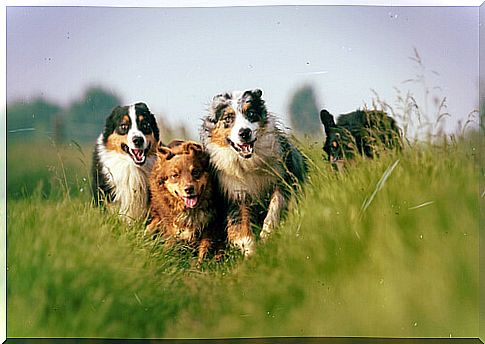At What Age Do Dogs Start Barking?

Barking is one of the ways dogs have to communicate and – as they do this for different reasons – they have a varied collection of “auaus”. But not just bark. They also growl, moan, howl, cry, complain, etc. And, if we left the sound chapter, we can get into body language, which has its ears and tail as its strengths. But at what point do these animals start making sounds?
barking is the voice of dogs

In two or three weeks of life, dogs perform their first vocalizations : growls and whimpers.
They will do it as soon as they start to open their eyes, as a way of calling their mother to bring them food and warmth.
Around the seventh week, they start with tiny barks. The time will depend on the races. Some, lazier ones, may take up to the 16th week to manifest in this way.
Dogs, from a very young age, bark for different reasons :
- To express excitement during play.
- To indicate that they are hungry, or that they need to go out to relieve themselves.
- Because they want to be given their favorite toy.
If you’ve just adopted a dog, you should know that they quickly learn that by barking they get your attention.
For this reason, the ideal is that you start with your dog’s education from the first moment, putting emphasis on not rewarding the barking that requires attention, as this would reinforce a bad habit.
As your pet grows, you will learn to identify its different types of bark. For example:
- When it detects an alleged threat (fear)
- To prevent an intruder from approaching your territory (defence)
- To invite another dog to play (social)
- As a form of threat to a competitor (domination)
And while barking varies by breed, smaller dogs tend to bark more.
How do dogs learn to bark?

Your dog will use his fellows as a source of inspiration. If he hears them barking, he is sure to do the same.
If you pay attention, it’s not uncommon that when a dog starts barking in your neighborhood, it quickly forms a chorus of all the dogs in the neighborhood.
If there is an adult dog in your home, surely a puppy will use it as a source of inspiration and imitate their actions. And, of course, barking will not be the exception to the rule.
When it comes to barking, it doesn’t end there. The dog may respond to barks coming from a television, ignition or to the “wow, wow” uttered by humans, to get their attention.
Barking can also be caused by sirens, car alarms and even high-pitched music.
As your dog socializes, he may bark at anything or anyone he doesn’t know. As the animal gets used to the house and recognizes it as its territory, barking can be a warning to ward off strangers or to let you know someone is approaching.
Remember that there is also another battery of sounds that your pet is also willing to use:
- The howl: It is a far-reaching form of communication for diverse circumstances. While howling is more closely associated with its kin, the wolves, your dog will not blink to use it.
- The growl: Will use it to frighten, warn, as a form of defense or aggression, or to show dominance. In that case, the growl will be accompanied by a straight look with goose bumps. But also, he may growl while playing, making movements with his tail to express joy.
- The moan: Equates to a happy look from humans. He will use it when he welcomes other dogs, people or other pets.
- The whining: Appears when showing submission or frustration. But also when something hurts. Or, simply, when you want to get your attention.
Before you go crazy with your dog’s barking and other sounds he makes, remember that this is normal dog behavior and that it has different functions.
And that what may seem like an uncomfortable noise for you, for your dog is a way of exchanging information and communicating with the same species, and informing humans about something they feel or perceive.
With patience and love, you will surely find a way to live peacefully with your dog and his barks.









